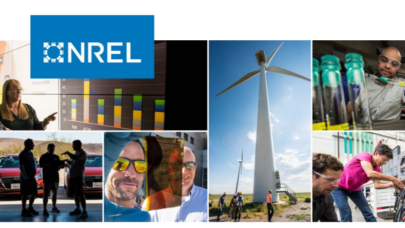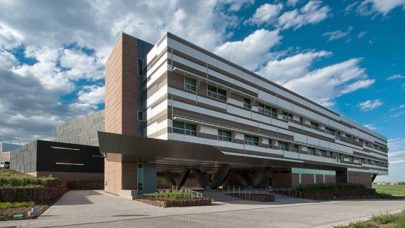
STEM-Trek NRG@SC23 Workshop: Inspiring and Enlightening!
December 18, 2023
STEM-Trek, a nonprofit that supports scholarly travel, mentoring, and advanced skills training for science, technology, engineering, and mathematics, hosted a p Read more…

NREL’s Kestrel Supercomputer Begins to Land
April 10, 2023
About a year and a half ago, HPE announced that it had been selected to build the next supercomputer for the DOE’s National Renewable Energy Laboratory (NREL) Read more…

2022 Road Trip Tour Stop #4: NREL
November 12, 2022
It’s only 25 miles from NCAR to NREL, so I have time to gas up, get a sandwich, and even catch a car wash before my tour stop at NREL. Feeling refreshed, I pu Read more…

With a Carbon Footprint Like HPC’s, It Matters When and Where You Step
December 9, 2021
From European HPC experts pondering “can fast be green?” to new milestones on the Green500 list, sustainability certainly had a moment at the hybrid SC21 conference. And it’s no wonder: the exascale era is here, and power consumption for HPC is skyrocketing even as efficiency is driven to its extremes. At SC21, another session – “HPC’s Growing Sustainability Challenges and Emerging Approaches” – tackled the topic... Read more…

ExaWind Prepares for New Architectures, Bigger Simulations
July 10, 2021
The ExaWind project describes itself in terms of terms like wake formation, turbine-turbine interaction and blade-boundary-layer dynamics, but the pitch to the Read more…

Aquarius Cold Plate Cooling System Tested by NREL, Sandia
March 7, 2019
In 2018, NREL and Sandia announced their intention to study the energy and cost savings of Aquila’s Aquarius cooling system in a real-world environment by installing a test system (“Yacumama”) at NREL. Now, nearly a year later, the partners have revealed the results of the test. Read more…

NREL ‘Eagle’ Supercomputer to Advance Energy Tech R&D
August 14, 2018
The U.S. Department of Energy (DOE) National Renewable Energy Laboratory (NREL) has contracted with Hewlett Packard Enterprise (HPE) for a new 8-petaflops (peak Read more…

Unlocking Wind’s Potential: Supercomputing’s Grand Challenge
August 30, 2017
A report released last week by the DOE’s National Renewable Energy Laboratory (NREL) asserts that supercomputing-led scientific advances could cut the unsubsidized cost of wind energy in half by the year 2030. Read more…

- Click Here for More Headlines

Whitepaper
Transforming Industrial and Automotive Manufacturing
In this era, expansion in digital infrastructure capacity is inevitable. Parallel to this, climate change consciousness is also rising, making sustainability a mandatory part of the organization’s functioning. As computing workloads such as AI and HPC continue to surge, so does the energy consumption, posing environmental woes. IT departments within organizations have a crucial role in combating this challenge. They can significantly drive sustainable practices by influencing newer technologies and process adoption that aid in mitigating the effects of climate change.
While buying more sustainable IT solutions is an option, partnering with IT solutions providers, such and Lenovo and Intel, who are committed to sustainability and aiding customers in executing sustainability strategies is likely to be more impactful.
Learn how Lenovo and Intel, through their partnership, are strongly positioned to address this need with their innovations driving energy efficiency and environmental stewardship.
Download Now
Sponsored by Lenovo
Whitepaper
How Direct Liquid Cooling Improves Data Center Energy Efficiency
Data centers are experiencing increasing power consumption, space constraints and cooling demands due to the unprecedented computing power required by today’s chips and servers. HVAC cooling systems consume approximately 40% of a data center’s electricity. These systems traditionally use air conditioning, air handling and fans to cool the data center facility and IT equipment, ultimately resulting in high energy consumption and high carbon emissions. Data centers are moving to direct liquid cooled (DLC) systems to improve cooling efficiency thus lowering their PUE, operating expenses (OPEX) and carbon footprint.
This paper describes how CoolIT Systems (CoolIT) meets the need for improved energy efficiency in data centers and includes case studies that show how CoolIT’s DLC solutions improve energy efficiency, increase rack density, lower OPEX, and enable sustainability programs. CoolIT is the global market and innovation leader in scalable DLC solutions for the world’s most demanding computing environments. CoolIT’s end-to-end solutions meet the rising demand in cooling and the rising demand for energy efficiency.
Download Now
Sponsored by CoolIT
Advanced Scale Career Development & Workforce Enhancement Center
Featured Advanced Scale Jobs:
HPCwire Resource Library
HPCwire Product Showcase
© 2024 HPCwire. All Rights Reserved. A Tabor Communications Publication
HPCwire is a registered trademark of Tabor Communications, Inc. Use of this site is governed by our Terms of Use and Privacy Policy.
Reproduction in whole or in part in any form or medium without express written permission of Tabor Communications, Inc. is prohibited.
























